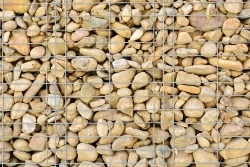 In light of the many studies that have been published that show the negative effects of commercial pesticide use, there has been a dramatic increase in the demand for locally sourced produce. The consumers who want to buy local produce also tend to favor those farms that utilize sustainable farming practices to reduce their environmental impact. Soil erosion removes valuable top soil, which results in decreased crop yields. This is one farming concern that can be mitigated with an eco-friendly solution known as "gabion retaining walls." Here is a quick guide from eHow about gabion construction.
In light of the many studies that have been published that show the negative effects of commercial pesticide use, there has been a dramatic increase in the demand for locally sourced produce. The consumers who want to buy local produce also tend to favor those farms that utilize sustainable farming practices to reduce their environmental impact. Soil erosion removes valuable top soil, which results in decreased crop yields. This is one farming concern that can be mitigated with an eco-friendly solution known as "gabion retaining walls." Here is a quick guide from eHow about gabion construction.
Site Preparation
Place stakes at the corners of the site where you intend to construct the gabion wall. Use the spade to dig up any grass or plants that might have roots under the wall.
Examine the earth under the wall. If it is soft soil or clay, dig down a few inches and fill the hole with gravel to give extra support to the weight of the wall.
Use a hoe to smooth the ground or gravel under the wall. Place a board on the ground and use the level to make sure the base of the wall is approximately level.
Place edging around the border of the site and place a weed mat over the ground under the wall to keep out weeds.
Installing the Wire Baskets
You can purchase prefabricated gabion wire baskets, or buy wire mesh such as chicken wire or construction wire mesh. Make sure the wire mesh you buy is galvanized or otherwise coated to resist corrosion.
Place the wire baskets on the ground where you want to build the wall. For prefabricated baskets, if the sides are already attached to the base, lay them flat with the base in the right location. If the sides are not attached, place the base in the right location and place the sides in position around it. For wire mesh, cut a base and lid of equal size, two ends of equal size and two equal sides. Place the base in position and the sides around it.
For baskets, use the galvanized wire to wire up the corners and sides to form a rectangular basket. Leave the lid open so you can put in the rocks. For wire mesh, use the galvanized wire to wire up the corners and the sides of the rectangular basket, leaving the lid open.
Insert the Rocks
Place the rocks inside the wire baskets. Use on-site rocks if they give you the appearance you want and are larger than the wire mesh holes. If you can't use on-site rocks, you'll need to plan to buy the correct size and type of rocks you'll need.
Place flat rocks with the flat side facing outward, and use angular or corner-shapes rocks for the corners. Use cement blocks for the middle of large gabion baskets to save rocks and speed filling of the baskets.
As you're filling the baskets, place wired cross-braces every three to six inches of height to reduce bulging. Join opposite sides of the baskets by wrapping the galvanized wire around part of the side's mesh, passing the wire across the stones and wrapping it around the mesh on the opposite side.
When you have filled the baskets, wire on the lids using heavy-duty staples and hog rings. Using special designed forceps for good ring closure and a double grip to ensure non-slip handling, our CL45 Gabion Ring is perfect for rockfall nets (as well as sacks or mattresses, lobster and other traps). Check out this video of the BECK Fastener Group®’s pneumatic tools and construction fasteners in action.
A well-constructed gabion retaining wall can provide years of protection from soil erosion for your crops. It can also be used as a decorative feature in your landscaping. Using filler materials from your construction site and long-lasting construction materials like galvanized metal fencing and reliable construction fasteners like BECK® 11g CL45 hog rings, you can build a gabion that will protect your crops and enhance your landscape for years to come.
.svg.png)

